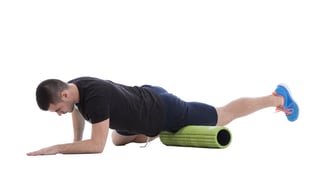How to Recover from High Intensity Workouts
April 18th, 2017 | 3 min. read


After challenging and high intensity workouts like Crossfit or sports training, recovery time is critical. Your body needs cool down time, followed by gentle stretching to keep your muscles, tendons, and ligaments flexible. You also need food—especially protein—and water to replenish lost nutrients and rebuild damaged tissue. If you skip any of these important steps after working out, you’re not saving time, but you may be sabotaging your results.
Most experienced athletes are familiar with the importance of warming up before workouts and cooling down after. These are standard strategies to protect against injury. But if you want to be even more proactive about heading off the possibility of getting hurt, there is even more you can do to stay healthy.
Proactive Recovery: At-Home Techniques
Pushing hard with cardio or resistance training can be tough on your body, especially if you’re engaging in this type of  workout on a regular basis. High-intensity exercise can subject your muscles, tendons, ligaments, and bone to impact stress and dehydration. After a particularly tough or long session, you may feel “twitchy” from dehydration or tight and sore from minor muscle strains and inflammation.
workout on a regular basis. High-intensity exercise can subject your muscles, tendons, ligaments, and bone to impact stress and dehydration. After a particularly tough or long session, you may feel “twitchy” from dehydration or tight and sore from minor muscle strains and inflammation.
Most of time, these reactions are a normal part of getting stronger. With sufficient downtime and nutrition, your body will replenish and repair itself. However, if you push too hard without enough breaks, you may develop areas of muscle cramping and spasms. Fascial adhesions within and around the muscles can also develop, leading to soreness, tightness, and range of motion problems. These are harder remedy on your own without the help of a physical therapist.
All athletes get injured at some point. However, by practicing these four proactive techniques after workouts, you can support your recovery process and keep your muscles looser and less prone to overuse injury.
- If you’re doing interval training, remember the 2:1 work-to-rest ratio. If you push hard for 10 minutes, take 5 minutes of rest. If you do a burst for 30 seconds (for example, a rapid series of pushups or burpees), pause for 15 seconds before starting another exercise. If you don’t rest between intervals, you’ll be tearing down muscle instead of building it up. After your workout is complete, cool down—for example, with slow walking—and stretch. Adequate rest is critical; make sure to allow time in your training plan for “low mileage days” or “low-intensity days” and rest days, as well.
- Foam roll. To keep muscles from seizing up after a workout, try foam rolling your tight spots after you cool down and before you stretch. Using a foam roller is a form of self-myofascial release: by putting pressure on trigger points in the muscles, you can break down knots and improve your range of motion. Foam rolling is like giving yourself a gentle pressure massage. The motion helps to promote circulation, too—keeping the blood flowing and your muscles warm and elastic.
- Stretching. During a hard workout, your muscles perform a series of repetitive contractions that leave them shortened and tight. Tight muscles become sore muscles; they can also change your posture, affecting your biomechanics and performance. To reset your body after a workout, move through a series of static stretches, paying particular attention to your most-used muscle groups and problem areas. Stretch both sides of your body, and hold each position for 30 seconds.
- Delayed-onset muscle soreness (DOMS) is part of the process of getting stronger. But because non-steroidal anti-inflammatory drugs (like ibuprofen or naproxen) can have side effects, taking them after every workout as a precaution against soreness is not advisable. Most personal trainers and coaches will suggest active recovery with low intensity movement instead. Ice the affected area if needed and stay mobile throughout the day to aid blood flow. However, if you have significant swelling and stiffness immediately after a workout—to the extent that it interferes with your performance or comfort—the occasional use of an NSAID can help to control pain and inflammation. NSAIDs should be used sparingly, especially if you have underlying medical conditions.
Proactive Recovery: Clinical Therapies
If you have old or recurring injuries or chronic tightness and soreness, the at-home, self-administered techniques listed  above may not go far enough for you. With some fascial adhesions, for example, all the foam rolling in the world may not be enough to break up the deep knots and layers of stickiness restricting your range of motion.
above may not go far enough for you. With some fascial adhesions, for example, all the foam rolling in the world may not be enough to break up the deep knots and layers of stickiness restricting your range of motion.
If you’ve tried NSAIDs, stretching, rest, and foam rolling and you’re not seeing the results you want, you may want to consider adding clinical therapies to your training regimen. Many physical therapists and orthopedists (including Coastal Ortho) offer a range of in-office, outpatient therapies that can aid post-workout recovery and help keep your muscles working efficiently.
The following techniques can help to stimulate blood flow, reduce pain, and improve flexibility. By adding them to your menu of recovery options, you may rebound faster after workouts and reduce the risk of future injury.
- Dry needling. Similar to acupuncture, this therapy requires inserting a hypodermic or acupuncture needle into the skin to stimulate myofascial trigger points in the skin and muscles. The goal is to reduce muscle tension and myofascial pain and to speed rehabilitation. One recent study has suggested that this drug-free approach may be as effective at providing pain relief as steroid injections.
- Graston technique. This manual, non-invasive therapy approach, also known as “soft-tissue instrument-assisted mobilization” or “scraping,” involves the use of specialized stainless steel instruments to massage the skin and break up scar tissue.
- Electric muscle stimulation (e-stim). This therapy involves the use of mild electrical currents to stimulate the nerves and muscles. It increases blood flow, removes lactic acid, releases endorphins, and promotes muscle relaxation. In the process, it reduces pain, builds muscle strength (particularly in atrophied areas), and promotes the healing process in injured tissue.
If you have any questions about high intensity workout recovery, feel free to call Coastal Orthopedics at (361) 994-1166.
Article written by: Rob Williams, MD
Dr. Williams has been practicing orthopedic surgery in Corpus Christi since 1998. After graduating from Texas Tech hereceived his medical degree from the University of Texas at San Antonio. At the prestigious Campbell Clinic located at the University of Tennessee, Dr. Williams completed not only an Orthopedic Surgery Residency, but an additional year of Fellowship Training in Spine Surgery. Dr. Williams is dedicated to creating an excellent patient experience in the office or in the surgery suite.
Topics:

